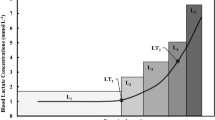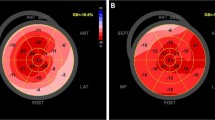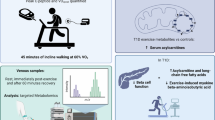Abstract
Patients with chronic heart failure (CHF) have limited exercise capacity. Exercise intolerance in CHF is associated with increased mortality; 1 moreover, several studies suggest that interventions that increase exercise capacity in CHF improve prognosis. 2–4 Therefore, as Kemps and colleagues state in this issue of the Netherlands Heart Journal, 5 exercise testing is an important tool for evaluating and monitoring heart failure.
Similar content being viewed by others
References
Davies LC, Wensel R, Georgiadou P, et al. Enhanced prognostic value from cardiopulmonary exercise testing in chronic heart failure by non-linear analysis: oxygen uptake efficiency slope. Eur Heart J 2006;27:684–90.
Smart N, Marwick TH. Exercise training for patients with heart failure: a systematic review of factors that improve mortality and morbidity. Am J Med 2004;116:693–706.
Rees K, Taylor RS, Singh S, et al. Exercise based rehabilitation for heart failure. Cochrane Database Syst Rev 2004;CD003331.
Piepoli MF, Davos C, Francis DP, et al. Exercise training metaanalysis of trials in patients with chronic heart failure (ExTraMATCH). BMJ 2004;328:189.
Kemps HM, Schep G, Hoogsteen J, Thijssen EJM, De Vries WR, Zonderland ML, et al. Oxygen uptake kinetics in chronic heart failure: clinical and physiological aspects. Neth Heart J 2009;17:238–44.
Andreacci JL, LeMura LM, Cohen SL, et al. The effects of frequency of encouragement on performance during maximal exercise testing. J Sports Sci 2002;20:345–52.
St Clair GA, Lambert MI, Hawley JA, et al. Measurement of maximal oxygen uptake from two different laboratory protocols in runners and squash players. Med Sci Sports Exerc 1999;31:1226–9.
Chua TP, Ponikowski P, Harrington D et al. Clinical correlates and prognostic significance of the ventilatory response to exercise in chronic heart failure. J Am Coll Cardiol 1997;29:1585–90.
Gademan MG, Swenne CA, Verwey HF, et al. Exercise training increases oxygen uptake efficiency slope in chronic heart failure. Eur J Cardiovasc Prev Rehabil 2008;15:140–4.
Hollenberg M, Tager IB. Oxygen uptake efficiency slope: an index of exercise performance and cardiopulmonary reserve requiring only submaximal exercise. J Am Coll Cardiol 2000;36:194–201.
Ingle L, Goode K, Carroll S, et al. Prognostic value of the VE/VCO2 slope calculated from different time intervals in patients with suspected heart failure. Int J Cardiol 2007;118:350–5.
Arena R, Humphrey R, Peberdy MA. Measurement of oxygen consumption on-kinetics during exercise: implications for patients with heart failure. J Card Fail 2001;7:302–10.
Sietsema KE, Ben Dov I, Zhang YY, et al. Dynamics of oxygen uptake for submaximal exercise and recovery in patients with chronic heart failure. Chest 1994;105:1693–1700.
Cohen-Solal A, Laperche T, Morvan D, et al. Prolonged kinetics of recovery of oxygen consumption after maximal graded exercise in patients with chronic heart failure. Analysis with gas exchange measurements and NMR spectroscopy. Circulation 1995;91:2924–32.
Rickli H, Kiowski W, Brehm M, et al. Combining low-intensity and maximal exercise test results improves prognostic prediction in chronic heart failure. J Am Coll Cardiol 2003;42:116–22.
Schalcher C, Rickli H, Brehm M, et al.: Prolonged oxygen uptake kinetics during low-intensity exercise are related to poor prognosis in patients with mild-to-moderate congestive heart failure. Chest 2003;124:580–6.
de Groote P, Millaire A, Decoulx E, et al. Kinetics of oxygen consumption during and after exercise in patients with dilated cardiomyopathy. New markers of exercise intolerance with clinical implications. J Am Coll Cardiol 1996;28:168–75.
Hayashida W, Kumada T, Kohno F, et al. Post-exercise oxygen uptake kinetics in patients with left ventricular dysfunction. Int J Cardiol 1993;38:63–72.
Koike A, Itoh H, Kato M, et al. Prognostic power of ventilatory responses during submaximal exercise in patients with chronic heart disease. Chest 2002;121:1581–8.
Kemps HM, Schep G, Zonderland ML, et al. Are oxygen uptake kinetics in chronic heart failure limited by oxygen delivery or oxygen utilization? Int J Cardiol 2009 [in press].
Gademan MG, Swenne CA, Verwey HF, et al. Effect of exercise training on autonomic derangement and neurohumoral activation in chronic heart failure. J Card Fail 2007;13:294–303.
Author information
Authors and Affiliations
Additional information
Department of Cardiology, Leiden University Medical Center, Leiden, the Netherlands
C.A. Swenne Department of Cardiology, Leiden University Medical Center, PO Box 9600, 2300 Leiden, the Netherlands
Rights and permissions
About this article
Cite this article
Gademan, M.G.J., van der Laarse, A., Swenne, C.A. et al. Oxygen uptake in heart failure: how much, how fast?. NHJL 17, 224–225 (2009). https://doi.org/10.1007/BF03086251
Issue Date:
DOI: https://doi.org/10.1007/BF03086251




